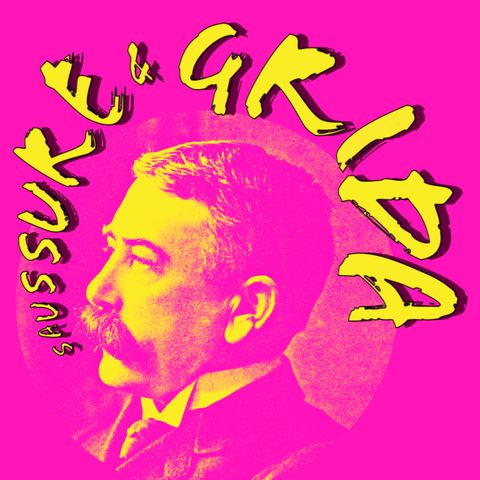11. Parolacce: una cosa da vietare o una risposta a bisogni umani?

Scarica e ascolta ovunque
Scarica i tuoi episodi preferiti e goditi l'ascolto, ovunque tu sia! Iscriviti o accedi ora per ascoltare offline.
Descrizione
Oggi ci immergiamo nel vibrante mondo delle parolacce, esplorando il loro impatto sulla società e la mente umana. Dalla loro origine evolutiva al loro ruolo nella nostra psicofisicità vediamo come...
mostra di piùGrafiche: Gianluca La Bruna
La sigla è stata prodotta da White Hot e fornita da https://freebeats.io
FONTI:
- Indian Penal Code. indiacode.nic.in. 1 May 1861.
- The Code of Administrative Offences of the Russian Federation, 20:1.
- Summary Offences Act 1981 No. 113 (as of 01 March 2017), Public Act – New Zealand Legislation
- Bergen, B.K. (2016). What the F: What swearing reveals about our language, our brains, and ourselves. New York: Basic Books
- Code, C. (2005). First in, last out? The evolution of aphasic lexical speech automatisms to agrammatism and the evolution of human communication. Interaction Studies, 6:311–334.
- Code, C. (2011). Nonfluent aphasia and the evolution of proto-language. Journal of Neurolinguistics, 24:136–144.
- Deacon, T.W. (2009). The Evolution of Language Systems in the Human Brain. Berkeley, CA: Elsevier, University of California.
- Diamond A. (2012). Activities and Programs That Improve Children's Executive Functions. Current directions in psychological science, 21(5):335–341.
- Eisenberger, N. I. (2012). Broken hearts and broken bones: A neural perspective on the similarities between social and physical pain. Current Directions in Psychological Science, 21:42–47.
- Fuster, J. M. (2002). Frontal lobe and cognitive development. Journal of Neurocytology, 31(3-5):373–385.
- Jackson, H.J. (1884). Evolution and dissolution of the nervous system. In J. Taylor (Ed.). Selected writings of John Hughlings Jackson, 11. London: Staples Press.
- Jay, T.B. (2009). The utility and ubiquity of taboo words. Perspectives on Psychological Science, 4:153-161.
- Jay, T.B, & Janschewitz, K. (2012). The science of swearing. Observer, 25(5), Association for Psychological Science.
- Jay, T.B., King, K. & Duncan, T. (2006). Memories of Punishment for Cursing. Sex Roles 55:123–133.
- Methven, E. (2018). A Little Respect: Swearing, Police and Criminal Justice Discourse. International Journal for Crime, Justice and Social Democracy. 7(3):58–74.
- Mohr, M. (2013). Holy shit: A brief history of swearing. Oxford: Oxford University Press.
- Montagu, A. (1967). The Anatomy of Swearing. New York: Macmillan.
- Pinker, S. (2007) The Stuff of Thought. New York: Viking Press.
- Progovac, L. & Benítez-Burraco, A. (2019). From Physical Aggression to Verbal Behavior: Language Evolution and Self-Domestication Feedback Loop. Frontiers in Psychology, 10:471-683.
- Robertson O.S., Robinson S.J., Stephens R. (2017). A cross-cultural comparison of the effects of swearing on pain perception in a British and Japanese population. Scandinavian Journal of Pain, 17(10):267–272.
- Savage, S. D. (2016). What not to swear: how do children learn bad words? Doctoral dissertation, University of Alabama Libraries.
- Singer, H.S. (2005). Tourette's syndrome: from behaviour to biology., in Lancet Neurology, 4(3):149-59.
- Stapleton, K. (2010). Swearing. In M.A. Locher, & S.L. Graham (Eds.), Interpersonal Pragmatics (Handbooks of Pragmatics 6) (289-306).
- Stephens, R., Atkins, J., & Kingston, A. (2009). Swearing as a response to pain. Neuroreport, 20(12):1056-1060.
- Stephens R., Robertson O. S. (2020). Swearing as a response to pain: Assessing hypoalgesic effects of novel “swear” words. Frontiers in Psychology, 11, 723.
- Van Lancker, D., & Cummings, J.L. (1999). Expletives: neurolinguistic and neurobehavioral perspectives on swearing. Brain Research Reviews, 31:83–104.
- Vingerhoets, A.J.J.M., Bylsma, L.M., & De Vlam, C. (2013). Swearing: A biopsychosocial perspective. Psychological Topics, 22(2), 287–304.
Informazioni
| Autore | Irene |
| Organizzazione | Irene Lami |
| Sito | - |
| Tag |
Copyright 2024 - Spreaker Inc. an iHeartMedia Company

Commenti